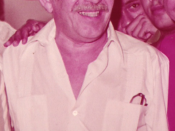It seems that in Gabriel Garcia Marquez' "The Handsomest Drowned Man in the World", the villagers are out there - really out there - on the edge of realism and surrealism. Starting with the kids who first saw the drowned man, initially they believed he was a ship and then a whale, these kids must have had the most creative imagination in twice their age group - I can't help to ask myself what these kids were on.
The central symbol in this story is a man who drowned and washed up on the shore of a small village. He was larger, heavier, better built and better looking than anyone the villagers had ever seen before. The identity created by the women for this man is Esteban. He is a product of the desires of these women. Esteban is a projection of these women's wills.
The main theme present is sight versus blindness.
First, the children discover the body and eventually realize that he is dead, yet they play with him as if he was another child. Then, the women are blind to the fact that he is crusty and muddy; they see his beauty. In contrast, the men see his awkwardness, but are blind to his splendor. All the villagers are blind to Esteban's real identity. They do not take him for who he really is. They only perceive what they want to.
In conclusion, the people in this small village contradict the clichéd small town people by accepting someone who is different from themselves. The people in the village discover that by accepting someone different into their society positive changes can occur.


